Resources
This page contains some key resources on walking and cycling, including an archive of the documents produced by the Australian Bicycle Council.
| Date Added | |||
|---|---|---|---|
 |
Gender Sensitive Urban Design Implementation Toolkit ACT Government The Gender Sensitive Urban Design (GSUD) Toolkit is a comprehensive resource designed to provide designers with essential principles, practices, and strategies for creating inclusive public spaces. With a particular focus on the needs of women, girls, gender diverse individuals, and other vulnerable people, the toolkit offers a range of strategies to address the multifaceted aspects of gender sensitivity in the public realm.
|
01/03/2024 | View |
 |
Planning and designing for active transport Department of Transport Western Australia Collaborating with and guiding state and local government and industry partners to plan, design and develop active transport solutions to help make it an easy choice for people of all ages and abilities to walk, wheel and ride. |
02/02/2024 | View |
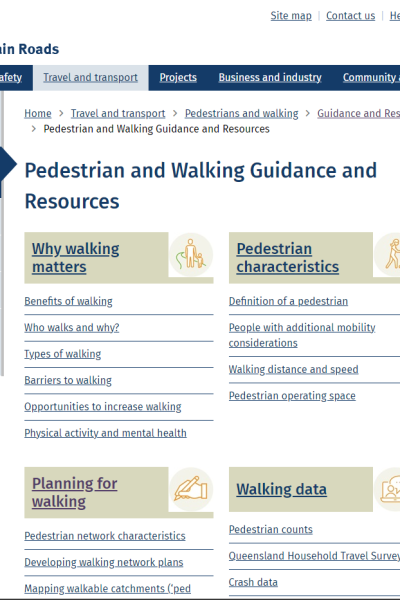 |
Pedestrian and Walking Guidance and Resources Department of Transport and Main Roads, Queensland Including:
|
13/10/2023 | View |
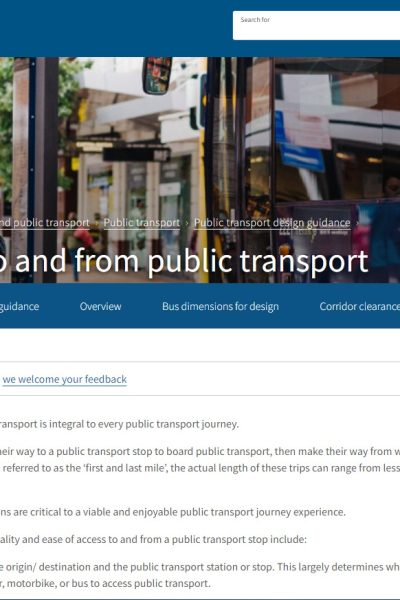 |
Getting to and from public transport Waka Kotahi NZ Transport Agency Getting to and from public transport is integral to every public transport journey. All passengers must make their way to a public transport stop to board public transport, then make their way from where they disembark to their final destination. Often referred to as the ‘first and last mile’, the actual length of these trips can range from less than 100m to many kilometres. First and last mile connections are critical to a viable and enjoyable public transport journey experience. Key issues relating to the quality and ease of access to and from a public transport stop include:
It is important that those involved in public transport planning consider the whole of the passengers' journey. When planning for public transport journeys, the following questions should be considered:
|
19/05/2023 | View |
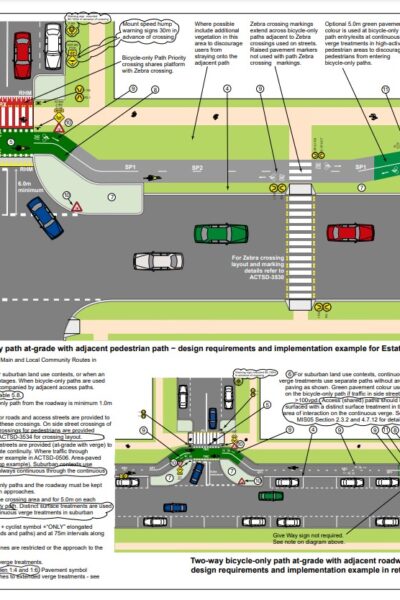 |
Municipal Design Standard Drawings Transport Canberra City Services The ACT Standard Drawings support the Municipal Infrastructure Design Standards and Technical Specifications. The Standard Drawings have been designed to be read in conjunction with the relevant referenced Municipal Infrastructure Standards (MIS) and Municipal Infrastructure Technical Specifications (MITS). The Standard Drawings provide detailed pictorial guidance for ACT civil assets, and reflects the most up-to-date industry practice. The design of and construction of municipal assets in the ACT must be in accordance with the Municipal Infrastructure Design Standards and Technical Specifications. Where any differences in practice exist between the Standard Drawings and the Municipal Infrastructure Standard, the later will prevail. |
08/07/2022 | View |
 |
Road Planning and Design Manual Department of Transport and Main Roads, Queensland The Road Planning and Design Manual is the Queensland Department of Transport and Main Roads' primary reference for the planning and design of roads. It refers designers to the relevant Austroads publications for technical requirements, and outlines where Queensland Department of Transport and Main Roads practice supplements or differs from the Austroads guides. |
08/07/2022 | View |
 |
Municipal Infrastructure Design Standards (MIS) Transport Canberra City Services The Municipal Infrastructure Standards (MIS) utilise the AusSpec document framework. This framework provides a level of design consistency across all local government jurisdictions in Australia, and reflects the most up-to-date industry practice. A number of local and regional government jurisdictions have adopted the AusSpec document framework as the primary technical framework for their design standards. |
08/07/2022 | View |
 |
Queensland Guide to Traffic Management Department of Transport and Main Roads, Queensland The Queensland Guide to Traffic Management (QGTM) is issued under the authority of Section 166 of the Transport Operations (Road Use Management) Act 1995. The contents of QGTM are issued as 'approved notices' under Section 166(2) of said Act. The Department of Transport and Main Roads has adopted Austroads' Guide to Traffic Management (AGTM) 2020 as part of national harmonisation. As a result, the QGTM will only provide requirements and recommendations specific to Queensland and has precedence over the equivalent Austroads Part. |
08/07/2022 | View |
 |
CWANZ Fact Sheet: Safety CWANZ Research has repeatedly shown that the more people walking or riding a bike, the safer it is for everyone. Reducing the number of cars and speed limits in built-up areas reduces the risk of death or injury to our most vulnerable road users. Growth in cycling is best achieved through separated cycle lanes and reduced speed limits. |
28/04/2022 | View |
 |
Research report 452 Predicting walkability Waka Kotahi NZ Transport Agency This research provides a number of mathematical formulas for predicting the quality of the walking environment from the perspective of the user using operational and physical variables. The formulas were derived by combining the perception data gathered from participants in the community street reviews with measurements of the walking environment. The two main areas that were researched to enable the derivation of formulas were:
This research describes the process for obtaining the data and deriving the formulas, and recommends the formulas most suitable for practitioner use. |
07/04/2022 | View |
 |
Healthy Streets Healthy Streets Towns and cities everywhere are facing the challenge of keeping communities healthy and happy. Healthy Streets® offers clients around the world an evidence-based approach to creating fairer, sustainable and attractive urban spaces. |
07/04/2022 | View |
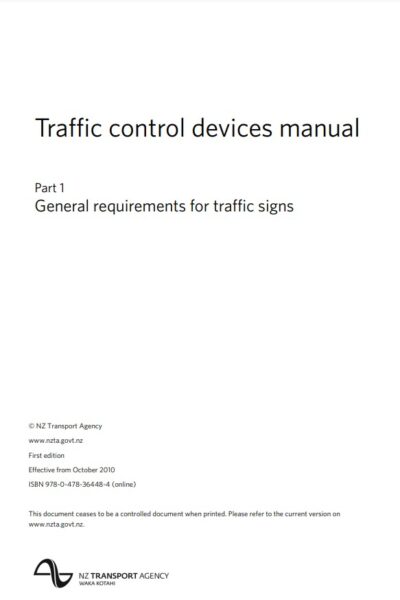 |
Traffic control devices manual (TCD manual) Waka Kotahi NZ Transport Agency The Traffic control devices manual (TCD manual) provides guidance on industry best practice, including, where necessary, practice mandated by law in relation to the use of traffic control devices. |
07/04/2022 | View |
 |
Tactical Urbanism Handbook Waka Kotahi NZ Transport Agency The draft Tactical Urbanism Handbook has been developed as a tool to help councils and communities deliver tactical urbanism projects to a high standard, using a collaborative best-practice approach. |
07/04/2022 | View |
 |
Streets for People Waka Kotahi NZ Transport Agency Creating a healthier future by putting people and place at the heart of our streets. |
07/04/2022 | View |
 |
Healthy Streets Waka Kotahi NZ Transport Agency Part of Urban Mobility and Liveable Cities Series. Featuring Claire Pascoe (Waka Kotahi NZ Transport Agency), Hamish Mackie (Mackie Research) and Lemauga Lydia Sosense, Chair Mangere Otahuhu Local Board. |
24/11/2021 | View |
 |
Tactile Indicator Installation Note - webinar Waka Kotahi NZ Transport Agency This webinar is for anyone involved in the design, installation and construction supervision of tactile ground surface indicators (TGSIs/tactile paving). |
19/10/2021 | View |
 |
Tactile Indicator Installation Note Waka Kotahi NZ Transport Agency The purpose of this technical note is to provide some high-level recommended practice to contractors carrying out the installation of tactile pavers as requested in an industry survey in 2018. This is a supplementary publication aimed at roading and utility contractors to provide a simple guide for reinstating tactile pavers affected by their works. |
19/10/2021 | View |
 |
RTS14 Guidelines for facilities for blind and vision impaired pedestrians Waka Kotahi NZ Transport Agency RTS 14 is the official guide that ensures that design and operation of roads and paths caters for blind and vision impaired pedestrians. It also takes into account the needs of people with impaired mobility. It provides detailed requirements for a continuous accessible path, tactile ground surface indicators and audible tactile traffic signal features. |
19/10/2021 | View |
 |
Bridging the Gap: NZTA Urban Design Guidelines Waka Kotahi NZ Transport Agency The guidelines seek to improve the understanding of what good urban design means in a transport project. The guidelines are intended for consultants, contractors, project managers, stakeholders and the community who participate in the planning, design, construction and maintenance of our transport networks. They are also intended for other Transport Agency staff whose work and actions affect urban design outcomes. |
19/10/2021 | View |
 |
Pedestrian Planning and Design Guide Waka Kotahi NZ Transport Agency The Pedestrian planning and design guide is New Zealand's comprehensive official guide to planning and design for walking. It sets out ways to improve New Zealand’s walking environment |
19/10/2021 | View |
 |
Trials Underway and Rules Changes Waka Kotahi NZ Transport Agency Keeps the industry up to date with cycle design trials that are currently underway, or have been completed in recent years, and also what cycling-related rules are being reviewed and when |
19/10/2021 | View |
 |
Designing a Cycling Facility Waka Kotahi NZ Transport Agency Provides users with best practice guidance, either directly or through links to appropriate sources for all stages of design, from concept stage through to detailed design |
19/10/2021 | View |
 |
Planning a Cycling Network Waka Kotahi NZ Transport Agency Provides users with best practice guidance, either directly or through links to appropriate sources for all stages of planning a cycle network |
19/10/2021 | View |
 |
Technical note #4: Buffered Cycle Lane Design Waka Kotahi NZ Transport Agency Guidance on the design of buffered cycle lanes for varying carriageway widths |
19/10/2021 | View |
 |
Technical note #2: Separated Cycleways at Side Roads and Driveways Waka Kotahi NZ Transport Agency This updated guidance covers how to design a priority-controlled cycle crossing of a side road or driveway |
19/10/2021 | View |
 |
Technical note #1: Separated Cycleway Options Tool Waka Kotahi NZ Transport Agency Guidance on use of the Separated cycleway options tool (SCOT), used to assist in the decision on whether to provide two 1-way facilities or a single 2-way facility on a particular route |
19/10/2021 | View |
 |
Buffered Advance Stop Box Waka Kotahi NZ Transport Agency Provides a treatment solution for advance stop boxes to improve visibility of cyclists from heavy vehicles and decrease the level of vehicle encroachment |
19/10/2021 | View |
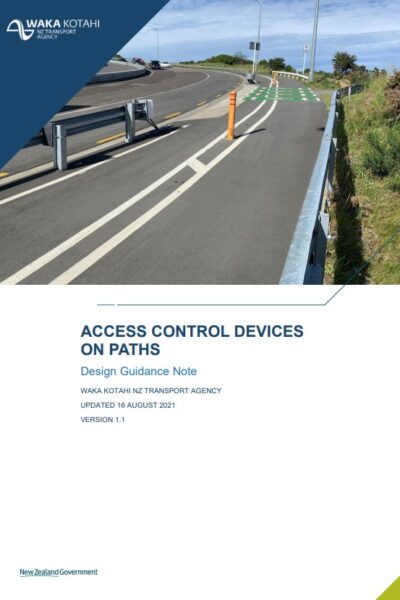 |
Access Control Devices Waka Kotahi NZ Transport Agency Guidance on the design, installation and management of access control devices on facilities where cyclists are permitted to be present. |
18/10/2021 | View |
 |
Considering Historic Heritage in Walking and Cycling Projects Waka Kotahi NZ Transport Agency The draft Handbook for tactical urbanism has been developed as a tool to help councils and communities deliver tactical urbanism projects to a high standard, using a collaborative best-practice approach. |
07/10/2021 | View |
 |
Draft Handbook for Tactical Urbanism in Aotearoa Waka Kotahi NZ Transport Agency The draft Handbook for tactical urbanism has been developed as a tool to help councils and communities deliver tactical urbanism projects to a high standard, using a collaborative best-practice approach. |
06/10/2021 | View |
 |
Shared and Separated Path Guidelines Department of Transport WA This document provides practitioners with guidance surrounding the planning and design of shared and separated paths in Western Australia to enable the safe and efficient movement of bicycle riders of all ages and abilities. It is intended to be a convenient and practical reference guide aimed at practitioners with varying levels of experience. |
06/10/2021 | View |
 |
Draft Handbook for tactical urbanism in Aotearoa - Guidance: roadway art Waka Kotahi NZ Transport Agency A supplement to the Handbook for tactical urbanism provides draft guidance on compliant application of using road artwork effectively and safely in New Zealand. |
30/09/2021 | View |
 |
High-use driveway treatment for cycle paths and shared paths Waka Kotahi NZ Transport Agency Provides a treatment solution for commercial and high-use access points on cycleways and shared paths. |
30/09/2021 | View |
 |
Cycle Parking Planning and Design Waka Kotahi NZ Transport Agency This guidance summarises best practice provision of parking and end-of-trip facilities for people who cycle. |
30/09/2021 | View |
 |
Signs and markings to designate paths for pedestrians and cyclists Waka Kotahi NZ Transport Agency Guidance on where and how to use markings and/or signs that designate paths for pedestrians and/or cyclists. |
30/09/2021 | View |
 |
Sharrow Markings Waka Kotahi NZ Transport Agency Guidance on the implementation of shared lane markings (‘sharrows’). |
30/09/2021 | View |
 |
Cycleway Separation Device Selection Matrix Waka Kotahi NZ Transport Agency Matrix comparing types of cycleway separation device, and issues to be considered. |
24/09/2021 | View |
 |
Cycling Network Guidance Waka Kotahi NZ Transport Agency Cycling network guidance – planning and design (CNG) framework aims to promote a consistent, best-practice approach to cycling network and route planning throughout New Zealand. |
06/09/2021 | View |
 |
Cycling Standards and Guidance Waka Kotahi NZ Transport Agency Cycling network guidance – planning and design (CNG) framework aims to promote a consistent, best-practice approach to cycling network and route planning throughout New Zealand. |
18/08/2021 | View |
 |
Towards Zero Growth: Healthy Weight Action Plan ACT Government Department of Health The action plan establishes local action to build on the work of the National Partnership Agreement on Preventive Health, the work of clinicians and nongovernment bodies, and on the many ACT programs already in place under our Healthy Weight Initiative. It will take the healthy weight agenda beyond the Health portfolio and improve coordination across government. |
21/07/2021 | View |
 |
Australasian Pedestrian Crossing Facility Selection Tool Austroads The Pedestrian Facility Selection Tool is designed to help Australian and New Zealand practitioners select the most appropriate type of pedestrian crossing based on walkability, safety and economic outcomes. |
20/05/2021 | View |
 |
Cycleway Design Toolbox Transport for NSW Need description |
17/05/2021 | View |
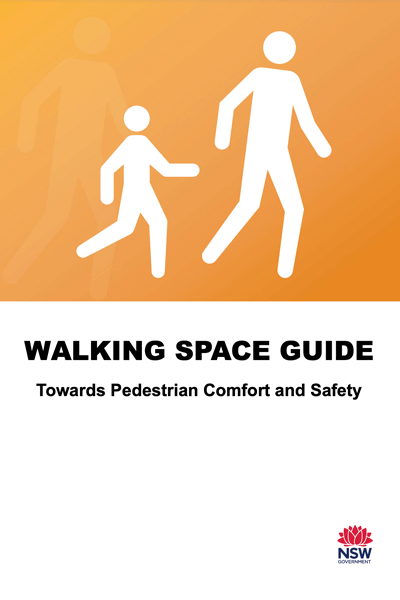 |
Walking Space Guide Transport for NSW The Walking Space Guide (Guide) provides a set of standards and tools to assist those responsible for Walking Spaces on streets, to ensure that sufficient space is provided to achieve comfortable environments which encourage people to walk. The Guide offers a clear, consistent set of standards and processes to be applied in designing, planning and implementing the amount of space to be provided according to the intensity of use. It is intended that designs are appropriate to the number of people using footpaths. This guide contains the method for carrying out a Walking Space assessment and offers guidance on how to understand the results. The guide includes an accompanying spreadsheet for recording data and calculating results. |
17/05/2021 | View |
